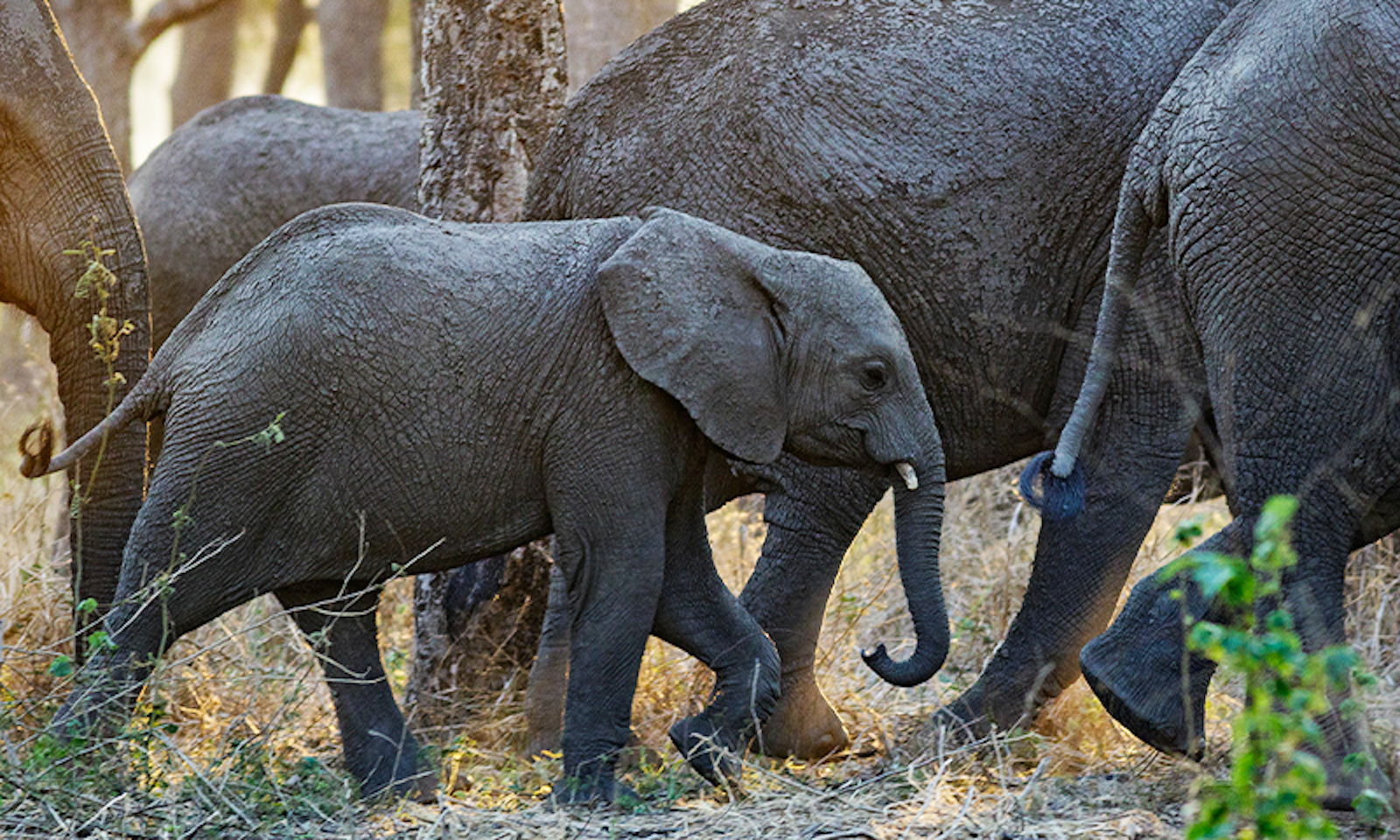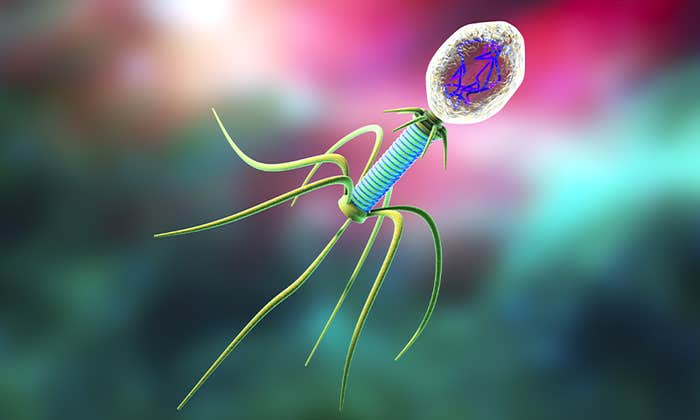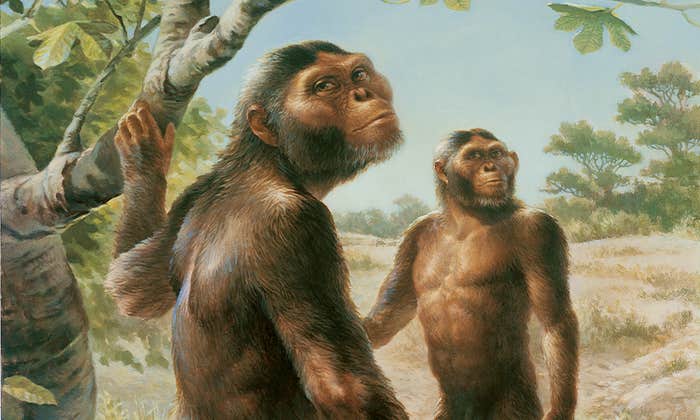
If, as the saying goes, elephants never forget, then the elephants in the wildlife haven of Gorongosa National Park probably remember Mozambique’s civil war better than some humans do. So indelible are the memories of the country’s 15-year-long civil war, which raged from 1977 to 1992, that they are written in the elephants’ genes.
As a result of the massive slaughter by the warring soldiers, who traded ivory to finance weapons for their protracted struggle, more and more elephants at Gorongosa are being born without their second most recognizable appendage: their tusks—natural selection deftly stepping in to make the species less attractive to human predators in only a few short generations.
It’s also made them into something of a churlish lot. Compared to elephant populations in, say, Kenya, Gorongosa’s trunk-swinging pachyderms are the éléphant terrible of their species—more apt to charge at humans driving Jeeps and Land Rovers, which they remember as death on four wheels. Whatever peace has been forged in the three decades since the war ended, it is—as far as the elephants are concerned—fragile and contingent.
The enormous ears of many elephants older than 30 are pierced with bullet holes.
“They’ve got a bit of an attitude,” said Joyce Poole, scientific director of the conservation nonprofit Elephant Voices, who has been studying elephants for nearly 50 years. “Many of the elephants in Gorongosa are old enough to remember vehicles bearing soldiers, and the younger ones learn from that behavior. It’s a transgenerational trauma.”
It’s in the lush expanse of Gorongosa National Park at the southern end of the lower Rift Valley—now more than 30 years into a major post-civil war rehabilitation—that the elephants are getting something of a reprieve. The merciless hunting during the conflict drove their local numbers down to less than 200 from a majestic pre-war population of about 4,000.1
Within Gorongosa’s protected world, the elephants are now regaining their groove as the ecosystem’s accidental public works department—toppling trees and munching tall grass, thereby blazing trails for other grazing animals in the park, like hippos, buffalo, zebras, and wildebeests. In their percussive wake, fallen brush provides shelter for antelope, who take cover from lions under jostled branches, and porcupines, who nest among the upturned roots. And those that do have tusks husk bark from trees in search of fibrous nutrients, meanwhile creating homes for certain tree-dwelling lizards.
Each of these 10-foot-tall beasts consumes as much as 300 pounds of leaves, shrubs, fruits, and roots in a single day and leaves behind enormous piles of dung, which help fertilize soil and spread seeds, furthering cycles of vegetation growth and ensuring plant diversity. Even the ground they tread bristles with life. Their footprints, indenting the earth under the weight of their 13,000-pound frames, can fill with rain and become havens for dozens of waterborne microscopic invertebrates. It’s not for nothing that those who study them often refer to them as “ecosystem engineers.”
Natural selection has deftly stepped in to make elephants less attractive to poachers.
Poole has been among elephants all her life. When she was 6 years old, she and her father were charged by one in Malawi. But the terror of that initial encounter gave way to an abiding fascination with the largest land-dwelling animals on the planet—as well as one of the most fascinating. And one of the most hunted.
Despite numerous international agreements that have forbidden the ivory trade since 1990, some 20,000 African elephants are poached each year, according to the World Wildlife Federation—part of an illicit wildlife trade estimated at $20 billion annually. The casualties of poaching are a major hit when the elephant population on the continent is estimated at only about 415,000—a precipitous drop from a century ago, when Africa was home to as many as 3 to 5 million of the species. In spite of ivory bans, poaching is so pervasive that the World Wildlife Federation predicts elephants may be no more as soon as 2040.
Between 2012 and 2019, Poole made numerous trips to study Gorongosa’s elephants. She says their population has bounced back to about 1,000 individuals. But they remain changed and hardened by war.
A tusk is essentially an overgrown tooth, which is a homologous structure to what we humans have in our own mouths in the spot where our incisors grow. But imagine having incisors that can grow to seven feet over the course of your life. Ivory comes from the teeth of mammals, and mammal teeth have three layers. The outer layer is made of hard enamel. The inner layer is made of the nerves and blood vessels that feed the tooth. The middle layer consists of a softer material called dentin, which we know as ivory.
Ivory is not a solid material. It contains a series of very small tubes filled with a waxlike liquid, and it is this structure that makes ivory easy to carve. It also gives polished ivory a warm, glowing tone—and it’s that tone that makes it so prized.
According to the Convention on International Trade in Endangered Species of Wild Fauna and Flora, the biggest ivory customer remains China, despite a national ban on ivory sales that took effect there in 2017. In Hong Kong, a hub of the illegal trade, ivory can sell for $3,000 a pound and a pair of carved tusks can fetch as much as $200,000. The poachers themselves get much less—only about $100 to $200 a pound—but in Africa, that goes far, especially when a pair of tusks from a mature male elephant can weigh as much as 250 pounds.
Criminal syndicates are behind much of the poaching and are often aligned with terrorist groups, like Uganda’s Lord’s Resistance Army, or the Al-Qaida-affiliated Al Shabab in Somalia, both of which are said to raise money through poaching. Mozambique enacted stiff anti-poaching laws in 2014, but recent reports in the African press on ivory seizures—where those arrested claimed to work for larger organizations—illustrate the ongoing dangers for the country’s elephants. And, from time to time, remnants of the civil war stubbornly crackle to life, threatening a return to the bloodshed of the past.

At some point before natural selection divided us out into separate mammalian species, elephants and humans shared a common ancestor in some other placental mammal. But where our much smaller teeth are designed to gnash and grind, elephants use their tusks for a host of other tasks like gathering and digging up food and water, excavating minerals, self-defense, and lifting objects in the fashion of a forklift.
Tusks also protect the elephant’s trunk, itself a dexterous and muscular marvel of evolution akin to our tongues—if only we could breathe and drink through them. And like us, elephants can be left- or right-handed—the favored tusk getting more worn down over time.
In Asian elephant populations, only the males have tusks. But tusks are sexually monomorphic among African elephants, meaning that both males and females have them. In safe circumstances—where generations have grown up protected from poachers—Poole told me that only about 2 or 3 percent of female elephants are born tuskless.
But, prior to the last several years, Gorongosa’s community of elephants has been anything but safe. Even before war broke out, elephants in Mozambique had been heavily poached. Poole said some 19 percent of female elephants in the area of Gorongosa were tuskless—a fact she confirmed by reviewing historical video footage and modern sighting records. This suggests that the adaptive selection against tusks, driven by poaching, began to gain a foothold even before the war.
After the war, the tuskless population spiked. Among 200 female elephants that Poole tracked, 51 percent that survived the war—animals that were 25 years or older—were tuskless. These then appeared to pass on this lack of tusks to their offspring: Some 32 percent of the female elephants born since the war have no tusks.
More than one Land Rover has been reduced to scrap metal by a head-butting matriarch.
Tusk weight increases with age, and male elephants have bigger and heavier tusks than females of the same age. “Poachers tend to focus on older males, but once they are depleted, older females become the target,” Poole said. As poachers select tusked over tuskless females, over time you start to get a much higher proportion of tuskless females, especially in the older age classes.”
These observations presented a unique and somewhat improbable question: Could tusklessness be an evolutionary response in action, one that we were observing in the here and now? And, if so, why was this occurring only in females? In 2021, Poole, along with Princeton biologist Shane Campbell-Stanton and others, made headlines in the world of science and beyond with a groundbreaking paper they published in Science.2 It revealed that the pressure on elephants from poaching had indeed spurred the rapid tuskless adaptation.
Campbell-Stanton and Brian Arnold, another Princeton biologist and a co-author on the paper, sequenced the genes of 11 elephants with tusks and seven without to identify stretches of DNA that differed between them. They also searched for places in the elephant genome that showed signs of recent natural selection without the random DNA reshuffling that happens over time.
They found two genes that seemed to be in play—and both are responsible for helping to produce enamel and build teeth in mammals. The one that best explains the phenomenon that Poole and Campbell-Stanton were observing among Gorongosa’s elephants is called AMELX, which occurs on the X chromosome.
This discovery also explained why only females are impacted. AMELX has some important neighbors without which an animal can’t survive. But since all these genes are packed tightly together, one gene can’t be affected without impacting another. A mutation affecting AMELX could bring down the entire organism if those neighboring genes are affected.
Females, however, can weather those perils because they have two X chromosomes. If the genes in one copy are damaged, they have a backup. Males—with their XY chromosomes—do not. This helped explain why Poole had seen less than a handful of tuskless males in her entire 50-year career—and none of them in Gorongosa. The mutation causes the males to die in the womb. It seems to have no other outwardly visible impact on the females, aside from their lack of tusks and the behavior they adapt to accommodate that, said Poole.
The researchers aren’t sure of exactly which mutations in AMELX have led to the tuskless trait. But a reflection in the human genome suggests they’re looking in the right place. In 2009, researchers studied a human subject who was missing AMELX and some of its neighbors. The subject was missing one incisor tooth and the other was very small. Those are the same teeth that, on elephants, grow into tusks.
What was so earth-shattering about this discovery among Gorongosa’s elephants is that we can see evolution occurring in a species with a comparatively long life. Poole’s research shows that elephants can live into their 70s. An elephant generation—the timespan during which an elephant matures from birth to reproductive age—takes about 14 to 17 years. For years, researchers assumed that rapid evolution was common only in small species. Poole and her coauthors confounded that. Now it’s clear that, thanks to humans, big, slow-breeding species like elephants, are impacted, too.
And Poole said that tusklessness isn’t limited just to Gorongosa.
Other countries have seen similar developments. South Africa, where early Boer settlers hunted elephants for ivory and then later made them the target of legal “extermination” campaigns, offers a grim example—98 percent of females in Addo Elephant National Park were tuskless in the early 2000s. In Tanzania’s Ruaha National Park, too—which, like Gorongosa, was heavily poached in the late decades of the last century—one in five female elephants older than 5 years old is tuskless.
Even if the loss of tusks is saving certain female elephants from poachers, the absence of these overgrown teeth in the ecosystem might have other consequences. Princeton’s Rob Pringle, another co-author on the 2021 paper on tuskless adaptation, showed in a separate, earlier paper how all that bark stripping and rooting around in the soil that elephants do with their tusks helps sculpt the savannah for other species.
The gene that produces tusklessness also appears to prevent mothers from having male calves, said Poole, although some mothers have given birth to males with tusks, who likely didn’t inherit the gene. But over time, this preponderance of tuskless females could impact population growth. Ecologists at Gorongosa National Park also want to look into whether tusklessness will change elephant’s diets, how they move nutrients from place to place, and how it affects other animals in their environment. There’s little doubt that it will change them—and the world around them.
Finally I fired my two remaining shots where I thought his heart must be,” wrote George Orwell in his 1936 essay “Shooting an Elephant.” “The thick blood welled out of him like red velvet, but still he did not die. His body did not even jerk when the shots hit him. He was dying, very slowly and in great agony, but in some world remote from me where not even a bullet could damage him further.”
The mechanics of the slaughter haven’t much changed since Orwell’s day. According to Pauwel de Wachter, the West Africa director for the World Wildlife Fund, the primary weapon of poachers is the AK-47, which they often fire from helicopters. But the bullets, he says, don’t kill the elephants immediately. Once the animal is felled, poachers are known to slice the tendons in the elephants’ legs to immobilize it. Sometimes they cut off its trunk so that it bleeds to death.
Other no less barbaric accounts suggest that some poachers use arrows and spears dipped in poison so that gunfire doesn’t draw the attention of rangers. Elephants killed like this die even more slowly, and their tusks can be cut off while they are still alive. It doesn’t take much to imagine that pain they feel—just picture your dentist sawing out your incisors without anesthetic.
The elephants are regaining their groove as the area’s accidental public works department.
It’s memories of this horror, says Poole, that so grip and preoccupy the elephants of Gorongosa, giving them their unfriendly reputation.
Each multi-generational elephant family, or herd, which can number as many as 100 individuals, consists of mothers and their babies. The matriarchs—usually the biggest and eldest females—are in charge. Male elephants stay with the family until they are about 10 years old, and then join other, older males. There they remain in smaller, all-male groups, sniffing around the peripheries, waiting to mate.
It is the social cues of the matriarch, says Poole, that hold the most influence over the herd. And as far as the matriarchs in Gorongosa are concerned, there’s a long way to go before humans can be viewed with much trust. This is especially the case among those who are older than 30 years and witnessed the civil war firsthand. Among those, Poole has observed elephants whose enormous ears are pierced with bullet holes.
It’s hardly a wonder that those matriarchs would charge at a vehicle full of humans. But the methods can differ from group to group.
“Different matriarchs and families use different tactics,” said Poole. In some families only the matriarch will charge a car—her ears spread, her feet churning up dust, punching the ground with a balled trunk and giving a blasting trumpet, “while the others cheer her on.” In others, the whole family will participate in a coordinated mobbing, gathering together and charging en masse, communication among them evident.
“The Gorongosa elephants still view vehicles as a threat and a new generation is learning from the behavior of their elders.” she said. “Only with time and consistent respectful behavior by drivers will they learn from experience that we are harmless.”
It can get dangerous. Poole’s brother Bob, the wildlife filmmaker who joined his sister on many of her missions to Gorongosa, has more than once had his Land Rover nearly reduced to scrap metal by a head-butting matriarch who was not keen on his presence. He outfitted it with a steel exoskeleton to deflect such blows, saving both his truck and, on some occasions, his own life.
Poole says this pugnacious demeanor, which stems directly from the elephant experience of poaching during the war, is something she has also observed in elephant populations in other places outside Gorongosa. Elephants in some of Kenya’s national parks, for instance, are suspicious of humans that are not in vehicles, Poole said. That’s because for decades, the Masai tribe hunted elephants on foot with spears. And it’s that image of humanity that’s etched into the collective memory of elephants there.
So would the elephants at Gorongosa be better off if we just left them alone and stopped forcing them to deal with humans? Poole said no. The will to protect Gorongosa as a National Park depends on the value of its biodiversity and its ability to draw in foreign exchange for the country, as well as for the benefit of local community projects. Without visitors, people could argue that the land could be better utilized for subsistence farming and fishing and hunting.
“The memory will take a long time to pass,” she said. “But making the peace is on us.” ![]()
Charles Digges is an environmental journalist and researcher who edits Bellona.org, the website of the Norwegian environmental group Bellona.
Lead photo by Piotr Naskrecki
The Nautilus Gorongosa Series is published in partnership with the Howard Hughes Medical Institute’s Science and Educational Media Group.
References
1. Poole, J. & Granli, P. The Gorongosa elephants through war and recovery: tusklessness, population size, structure and reproductive parameters. Pachyderm 63, 38-54 (2022).
2. Campbell-Staton, S.C., et al. Ivory poaching and the rapid evolution of tusklessness in African elephants. Science 374, 483-487 (2021).


























